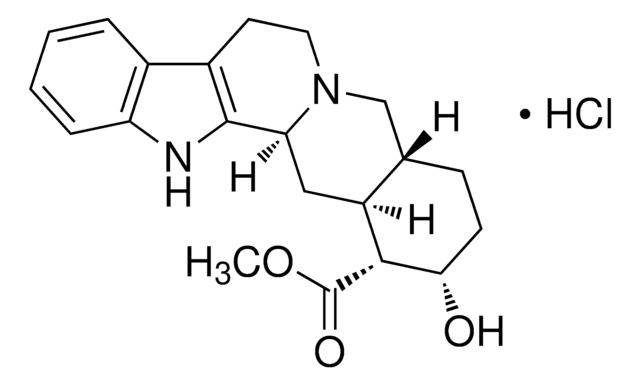H0879
Hexamethonium bromide
Synonym(s):
Hexane-1,6-bis(trimethylammonium bromide), N,N,N,N′,N′,N′-Hexamethylhexamethylenediammonium dibromide
About This Item
Recommended Products
mp
282-285 °C (dec.)
SMILES string
[Br-].[Br-].C[N+](C)(C)CCCCCC[N+](C)(C)C
InChI
1S/C12H30N2.2BrH/c1-13(2,3)11-9-7-8-10-12-14(4,5)6;;/h7-12H2,1-6H3;2*1H/q+2;;/p-2
InChI key
FAPSXSAPXXJTOU-UHFFFAOYSA-L
Gene Information
human ... CHRNA1(1134) , CHRNA10(57053) , CHRNA2(1135) , CHRNA3(1136) , CHRNA4(1137) , CHRNA5(1138) , CHRNA6(8973) , CHRNA7(1139) , CHRNA9(55584) , CHRNB1(1140) , CHRNB2(1141) , CHRNB3(1142) , CHRNB4(1143)
Looking for similar products? Visit Product Comparison Guide
Application
- as an autonomic ganglia-blocking agent to study its effects on whisker movement in rats
- as a nicotinic receptor antagonist to study its effects on antigen-induced arthritis (AIA) progression in mice
- as a non-selective ganglionic nicotinic acetylcholine receptor (nAChR) antagonist to study its effects on cytisine-induced autonomic cardiovascular responses in mice
Biochem/physiol Actions
Features and Benefits
Storage Class Code
11 - Combustible Solids
WGK
WGK 2
Flash Point(F)
Not applicable
Flash Point(C)
Not applicable
Personal Protective Equipment
Certificates of Analysis (COA)
Search for Certificates of Analysis (COA) by entering the products Lot/Batch Number. Lot and Batch Numbers can be found on a product’s label following the words ‘Lot’ or ‘Batch’.
Already Own This Product?
Find documentation for the products that you have recently purchased in the Document Library.
Customers Also Viewed
Our team of scientists has experience in all areas of research including Life Science, Material Science, Chemical Synthesis, Chromatography, Analytical and many others.
Contact Technical Service













